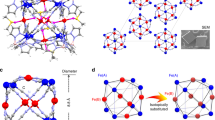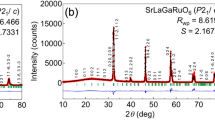Abstract
Spin transition has attracted the interest of researchers in various fields since the early 1930s, with thousands of examples now recognized, including those in minerals and biomolecules. However, so far the metal centres in which it has been found to occur are almost always octahedral six-coordinate 3d4 to 3d7 metals, such as Fe(II). A five-coordinate centre is only rarely seen. Here we report that under pressure SrFe(II)O2, which features a four-fold square-planar coordination, exhibits a transition from high spin (S = 2) to intermediate spin (S = 1). This is accompanied by a transition from an antiferromagnetic insulating state to a ferromagnetic so-called half-metallic state: only half of the spin-down (dxz,dyz) states are filled. These results highlight the square-planar coordinated iron oxides as a new class of magnetic and electric materials.
This is a preview of subscription content, access via your institution
Access options
Subscribe to this journal
Receive 12 print issues and online access
$259.00 per year
only $21.58 per issue
Buy this article
- Purchase on Springer Link
- Instant access to full article PDF
Prices may be subject to local taxes which are calculated during checkout




Similar content being viewed by others
References
Gütlich, P. & Goodwin, H. A. Spin Crossover in Transition Metal Compounds I–III, Vols 233–235 (Springer, 2004).
Kröber, J., Codjovi, E., Kahn, O., Croliére, F. & Jay, C. A spin transition system with a thermal hysteresis at room temperature. J. Am. Chem. Soc. 115, 9810–9811 (1993).
Real, J. A. et al. Spin crossover in a catenane supramolecular system. Science 267, 265–267 (1995).
Badro, J. et al. Iron partitioning in earth's mantle: toward a deep lower mantle discontinuity. Science 300, 789–791 (2003).
Lin, J.-F. et al. Spin transition of iron in magnesiowüstite in the earth's lower mantle. Nature 436, 377–380 (2005).
Rueff, J.-P. et al. Pressure-induced high-spin to low-spin transition in FeS evidenced by X-ray emission spectroscopy. Phys. Rev. Lett. 82, 3284–3287 (1999).
Li, J. et al. Electronic spin state of iron in lower mantle perovskite. Proc. Natl Acad. Sci. USA 101, 14027–14030 (2004).
Takano, M. et al. Pressure-induced high-spin to low-spin transition in CaFeO3 . Phys. Rev. Lett. 67, 3267–3270 (1991).
Decurtins, S., Gütlich, P., Köhler, C. P., Spiering, H. & Hauser, A. Light-induced excited spin state trapping in a transition-metal complex: the hexa-1-propyltetrazole-iron (II) tetrafluoroborate spin-crossover system. Chem. Phys. Lett. 105, 1–4 (1984).
Qi, Y., Müller, E. W., Spiering, H. & Gütlich, P. The effect of a magnetic field on the high-spin ↔ low-spin transition in [Fe(phen)2(NCS)2]. Chem. Phys. Lett. 101, 505–505 (1983).
Ikeue, T. et al. Saddle-shaped six-coordinate iron(III) porphyrin complexes showing a novel spin crossover between S = 1/2 and S = 3/2 spin state. Angew. Chem. Int. Ed. 40, 2617–2620 (2001).
Halder, G. J., Kepert, C. J., Moubaraki, B., Murray, K. S. & Cashion, J. D. Guest-dependent spin crossover in a nanoporous molecular framework material. Science 298, 1762–1765 (2002).
Nakano, N., Nakano, K. & Tasaki, A. A magnetic study of acidic ferric hemoglobin. Biochem. Biophys. Acta 251, 301–313 (1971).
Moritomo, Y. et al. Metal–insulator transition induced by a spin-state transition in TbBaCo2O5+δ (δ = 0.5). Phys. Rev. B. 61, R13325–R13328 (2000).
Tsujimoto, Y. et al. Infinite-layer iron oxide with a square-planar coordination. Nature 450, 1062–1065 (2007).
Köhler, J. Square-planar coordinated iron in the layered oxoferrate(II) SrFeO2 . Angew. Chem. Int. Ed. 47, 4470–4472 (2008).
Kawakami, T. et al. High-pressure Mössbauer and X-ray powder diffraction studies of SrFeO3 . J. Phys. Soc. Jpn 72, 33–36 (2003).
Perdew, M., Ernzerhof, M. & Bruke, A. Rationale for mixing exact exchange with density functional approximations. J. Chem. Phys. 105, 9982–9985 (1996).
Paier, J. et al. Screened hybrid density functionals applied to solids. J. Chem. Phys. 124, 154709 (2006).
Xiang, H. J., Wei, S.-H. & Whangbo, M.-H. Origin of the structural and magnetic anomalies of the layered compound SrFeO2: a density functional investigation. Phys. Rev. Lett. 100, 167207 (2008).
Pruneda, J. M., Inigquez, J., Canadell, E., Kageyama, H. & Takano, M. Understanding the unique structural and electronic properties of SrFeO2 . Phys. Rev. B 78, 115101 (2008).
Hwang, H. Y. & Cheong, S.-W. Enhanced intergrain tunneling magnetoresistance in half-metallic CrO2 films. Science 278, 1607–1609 (1997).
Kimura, T. et al. Interplane tunneling magnetoresistance in a layered manganite crystal. Science 274, 1698–1701 (1996).
Okimoto, Y. et al. Anomalous variation of optical spectra with spin polarization in double-exchange ferromagnet: La1–xSrxMnO3. Phys. Rev. Lett. 75, 109–112 (1995).
Shimakawa, Y., Kubo, Y. & Manako, T. Giant magnetoresistance in Tl2Mn2O7 with the pyrochlore structure. Nature 379, 53–55 (1996).
Park, J.-H. et al. Direct evidence for a half-metallic ferromagnet. Nature 794, 794–796 (1998).
Kageyama, H. et al. Spin-ladder iron oxide Sr3Fe2O5 . Angew. Chem. Int. Ed. 47, 5740–5745 (2008).
Tassel, C. et al. Stability of the infinite layer structure with iron square planar coordination. J. Am. Chem. Soc. 130, 3764–3765 (2008).
Tassel, C. et al. CaFeO2: a new type of layered structure with iron in a distorted square planar coordination. J. Am. Chem. Soc. 130, 214410–214419 (2008).
Kamihara, Y., Watanabe, T., Hirano, M. & Hosono, H. Iron-based layered superconductor La[O1–xFx]FeAs (x = 0.05–0.12) with Tc = 26 K. J. Am. Chem. Soc. 130, 3296–3297 (2008).
Bassett, W. A., Takahashi, T. & Stook, P. W. X-ray diffraction and optical observations on crystalline solids up to 300 kbar. Rev. Sci. Instrum. 38, 37–42 (1967).
Arora, A. K., Yagi, T., Miyajima, N. & Mary, T. A. Amorphization and decomposition of scandium molybdate at high pressure. J. Appl. Phys. 97, 013508 (2005).
Kresse, G. & Furthmuller, J. Efficiency of ab-initio total energy calculations for metals and semiconductors using a plane-wave basis set. Comput. Mater. Sci. 6, 15–50 (1996).
Kresse, G. & Joubert, D. From ultrasoft pseudopotentials to the projector augmented-wave method. Phys. Rev. B 59, 1758–1775 (1999).
Perdew, J. P., Burke, K. & Ernzerhof, M. Generalized gradient approximation made simple. Phys. Rev. Lett. 77, 3865–3868 (1996).
Paier, J., Hirschl, R., Marsman, M. & Kresse, G. The Perdew–Burke–Ernzerhof exchange-correlation functional applied to the G2-1 test set using a plane-wave basis set. J. Chem. Phys. 122, 234102 (2005).
Acknowledgements
This work was supported by Science Research on Priority Areas (Novel States of Matter Induced by Frustration) and also partly by the Ministry of Education, Culture, Sports, Science and Technology of Japan. Research at Oak Ridge National Laboratory was sponsored by the Division of Materials Sciences and Engineering, US Department of Energy, under contract with UT-Battelle. This research used resources of the National Energy Research Computing Center, which is supported by the Office of Science of the US Department of Energy. This work was supported by the University of Vienna through the University Focus Research Area Materials Science (Multi-scale Simulations of Materials Properties and Processes in Materials).
Author information
Authors and Affiliations
Contributions
H.K. designed and coordinated the overall study seeking advice from M.T. (experiment) and C.L.F. (theory). N.H. conceived the high-pressure Mössbauer study, and X-Q.C. conceived the theoretical studies. Y.T., with support from K.Y., synthesized the material. T.K., S.S., K.H., Y.S. and Y.M. conducted high-pressure Mössbauer and electrical resistivity experiments, and T.K. analysed the data (with the help of M.T. and S.N.). Y.T., C.T., A.K., T.O. and T.Y. performed high-pressure X-ray diffraction experiments, and Y.T. and C.T. analysed the data. X-Q.C., C.L.F. and R.P. performed the theoretical work and analysis. H.K. and T.K. co-wrote the experimental part and C.L.F. and X-Q.C. co-wrote the theoretical part, with comments from R.P. All contributed to the discussion of the results.
Corresponding author
Supplementary information
Supplementary information
Supplementary information (PDF 738 kb)
Rights and permissions
About this article
Cite this article
Kawakami, T., Tsujimoto, Y., Kageyama, H. et al. Spin transition in a four-coordinate iron oxide. Nature Chem 1, 371–376 (2009). https://doi.org/10.1038/nchem.289
Received:
Accepted:
Published:
Issue Date:
DOI: https://doi.org/10.1038/nchem.289
This article is cited by
-
Geometric frustration of Jahn–Teller order in the infinite-layer lattice
Nature (2023)
-
Electrostatic gating and intercalation in 2D materials
Nature Reviews Materials (2022)
-
Exceptionally robust magnetism and structure of SrFeO\(_2\) above 100 GPa
Scientific Reports (2022)
-
Strain-induced creation and switching of anion vacancy layers in perovskite oxynitrides
Nature Communications (2020)
-
Emergent superconductivity in an iron-based honeycomb lattice initiated by pressure-driven spin-crossover
Nature Communications (2018)



